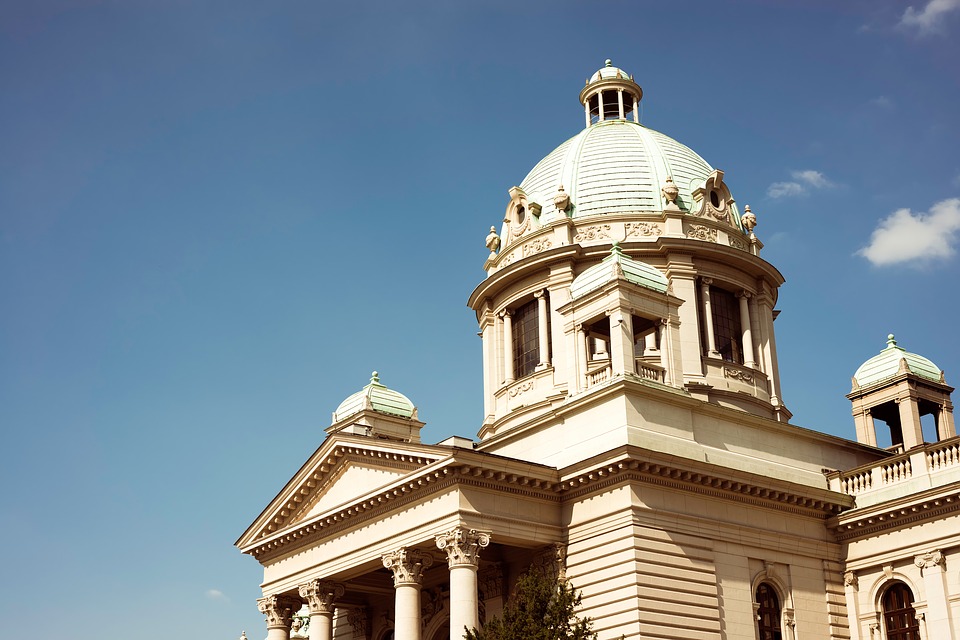Početkom dvadesetog veka, na mestu na kojem je danas Narodna skuptšina, nalazila se Batal džamija, koju su mnogi upoređivali sa Aja Sofijom u Istanbulu. U borbama za Beograd prilično je oštećena, ali je takva još dugo opstajala na tom mestu, a knez Miloš nije zabranio njenu popravku. Knez Mihailo govorio je kako bi se ona mogla preurediti i koristiti kao Državna arhiva, ali namesnik Blaznavac je 1869. doneo konačnu odluku o njenom rušenju.

Nešto kasnije, doneta je odluka da se na tom mestu izgradi zgrada Parlamenta. Zgrada u kojoj je do tada zasedala Narodna skupština bila je skromna i nedostojna za tada proglašenu Kraljevinu Srbiju. Kralj Petar I Karađorđević 1907. godine položio je kamen temeljac, međutim, izbijanjem Prvog svetskog rata gradnja je obustavljena. Tek 1936. godine ova zgrada je konačno podignuta i samo dva dana kasnije u njoj je održano prvo zasedanje Narodne skupštine Kraljevine Jugoslavije.
Dom Narodne skuštine je Drugi svetski rat, nemačko i savezničko bombarodvanje Beograda preživeo neoštećen. Nakon toga rata, u ovoj zgradi odigralo se dosta značajnih stvari – zasedanja AVNOJ-a, u njoj je donet prvi Ustav Federativne Narodne Republike Jugoslavije, proglašena je FNRJ, održana je Prva konferencija nestvrstanih zemalja i još mnogo drugih značajnih doagađaja.
Zbog svega toga, za Dom Narodne Skuštine kaže se da je svedočio najvećim i najznačajnijim događajima u novijoj srpskoj istoriji. Ono što je svakako sigurno jeste da je ova građevina po mišljenju mnogih jedna od najlepših u Beogradu i da nikoga, pa čak ni slučajne prolaznike, neće ostaviti ravnodušnim.
HOME OF THE NATIONAL ASSEMBLY – CROSSROAD BUILDING WHICH SURRVIVED WAR AND BOMBING
At the beginning of the twentieth century, at the place where the National Assembly IS today, there was a Batal mosque, which many compared with Ayia Sofia in Istanbul. In the battles for Belgrade, mosque was badly damaged, but remained in that place for a long time. Knez Milos forbid her correction. Knez Mihailo spoke that it could be reorganized and used as a State Archives, but in 1869, the deputy Blasnavac made the final decision on its demolition.
After that, it was decided to build a Parliament building on that place. The building in which the National Assembly was at that moment was modest and unworthy of declared Kingdom of Serbia. King Peter I Karađorđević laid the cornerstone in 1907, but the construction of the building was abandoned by the outbreak of the First World War. In 1936 this building was finally built and only two days later the first session of the National Assembly of the Kingdom of Yugoslavia was held.
The house of National Asembly survived Second World War and the German and Allied Bombing of Belgrade undamaged. After this war, there were many important happenings in this building – the AVNOJ session, the first Constitution of the Federal People’s Republic of Yugoslavia was adopted, FNRJ was proclaimed, the First Conference of Non-Aligned Countries was held and many other important insights took place here.
Because of all this, we say that the house of the National Assembly testified to the largest and most important events in recent Serbian history. What is certainly is that this building, in the opinion of many, is one of the most beautiful in Belgrade and that nobody, and even accidental passers-by, will not be left indifferent.
GLAS NACIJE












